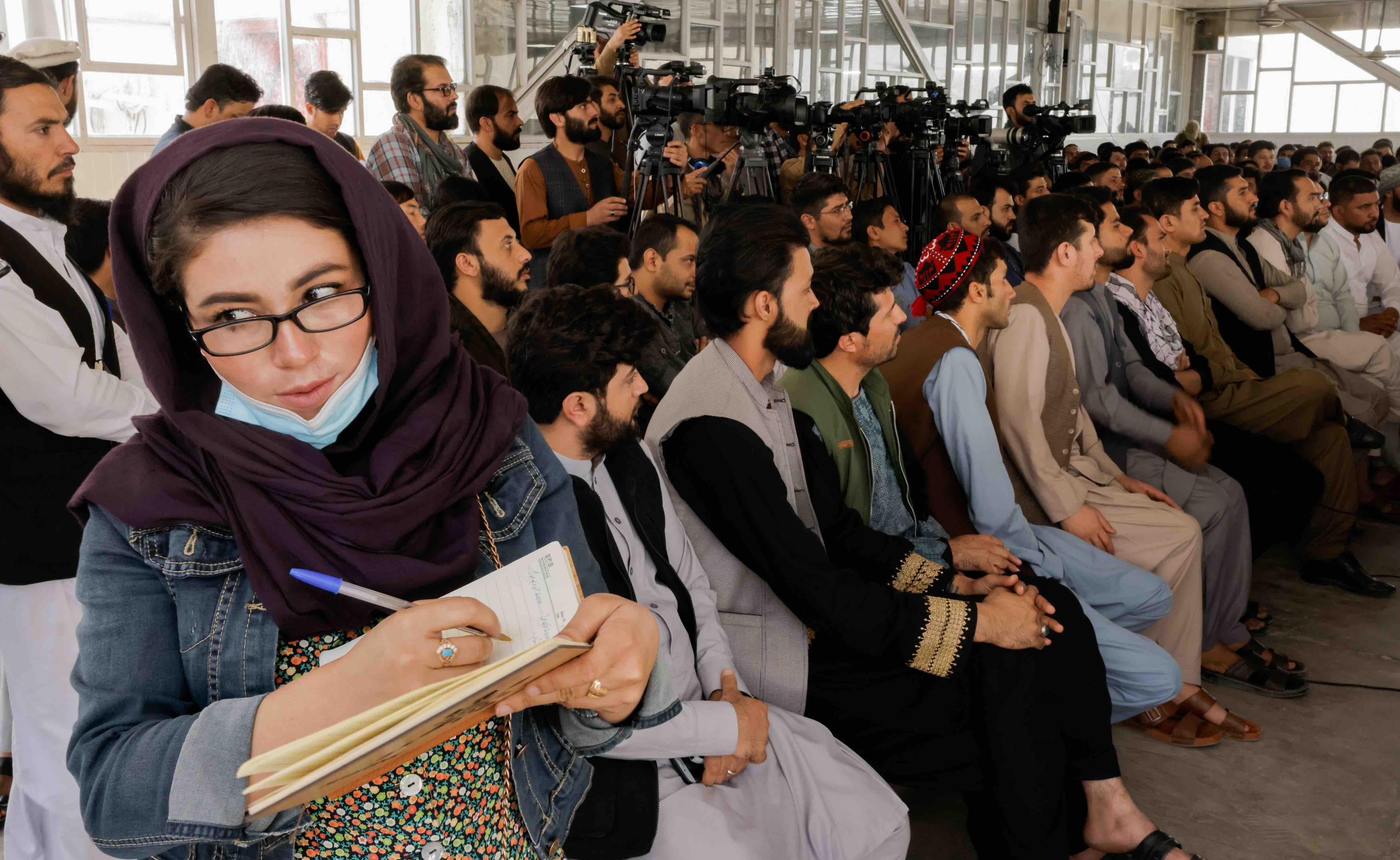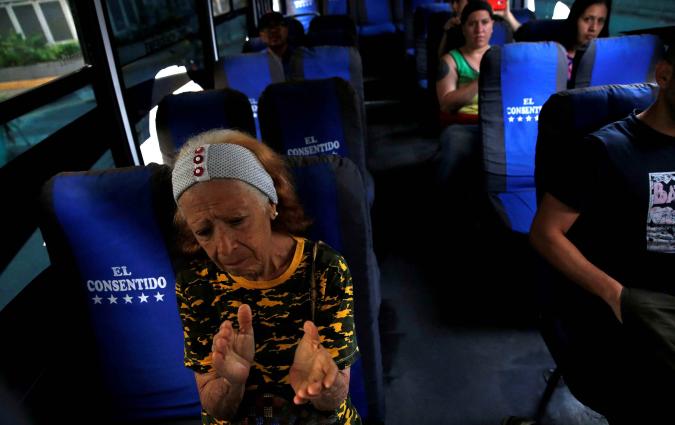As winter approaches, Afghan women journalists speak out: "I enjoyed all the liberties of life. Now I feel like a prisoner"

An Afghan female journalist attends a Taliban officials news conference in Kabul on 5 October 2021. REUTERS/Jorge Silva
As one of the harshest of winters sets on Afghanistan, many voices are reminding us that the humanitarian crisis in the country is also a human rights crisis, and particularly a women’s rights crisis.
As women disappear from the public sphere, Afghan women journalists are vanishing at a rapid pace. Of the total number of women journalists in 2020, only 5% live and work in Kabul since the Taliban took back control. According to a survey by Reporters Sans Frontières (RSF) and the Centre for the Protection of Afghan Women Journalists (CPAWJ), only 76 media professionals (including 39 journalists) are still currently working from Kabul. 700 women journalists were working in the Afghan capital in 2020.
Over 250 media outlets have been shut in the last four months due to financial problems and restrictions on media operations. Over 70% of media workers are either unemployed or have fled the country. In November, the Taliban’s Ministry for the Promotion of Virtue and Prevention of Vice issued a directive which made the hijab compulsory for women television journalists. “The Taliban’s new media regulations and threats against journalists reflect broader efforts to silence all criticism of Taliban rule,” said Patricia Gossman, Associate Asia Director at Human Rights Watch. “The disappearance of any space for dissent and the worsening restrictions for women in the media and arts are devastating.”
A tough winter
As Afghanistan moves into this winter, the priority is immediate humanitarian assistance – safe houses, living costs and basic necessities for the survival of those who remain in Afghanistan at a time when their livelihoods and their identity as journalists have been snatched away. These are the recommendations in a report on women journalists in Afghanistan recently published by the Network of Women in Media in India and The Media Safety & Solidarity Fund.
The report details the plight of Afghan women journalists, both within the country and those who fled the conflict-ridden nation, in great detail. “Unfortunately, the daily life of journalists and people is abnormal. There is no security, the income of the people is zero, and some journalists recently committed suicide because of the weak economy,” says a 25-year-old journalist from one of the northern provinces in Afghanistan quoted in the report. She was working as a reporter at a radio station and had to move to another city in Afghanistan following threats.
The achievements and progress that Afghan women had achieved after 9/11 are gone and it may take another 20 years to make that progress, lamented a 19-year-old reporter writing for a news website in Kabul. She continues to work in the country and said it was getting increasingly tougher for journalists to function.
An 18-year-old who was a producer and presenter at an FM radio station and television channel at Wardak province stopped working when the Taliban took over the country. The radio and TV channels were established by her father. “We moved from Wardak province to Kabul, and now we have many economic and security problems,” she said. With winter approaching, her family is now facing food shortages. They feel stuck in Kabul, she said. “As a young journalist who enjoyed all the liberties of life, now that we do not have the right to study, the right to work, the right to freedom of expression and the right to travel. I feel like a prisoner,” she said.
Helping people like her is not easy. The Associated Press donated prints for a photo print fundraiser to help Afghan women journalists through these tough times. A total of USD 100,000 has been collected. However, the problems with Afghanistan’s banking system have made it difficult to transfer funds, said Jeremy Dear, IFJ Deputy General Secretary, who is leading IFJ’s international response to Afghanistan.
Afghan women journalists abroad
A radio journalist from Kabul hurriedly left for India in August, barely managing to grab her essentials. She said she was petrified until the aircraft touched down in India and speaks on the phone in a hushed voice even now. “I feel someone might be listening to me even when I know no one is,” she said. She requested anonymity as her family continues to live in Afghanistan. Since she was the only breadwinner in her family of nine, she fears for their future. “More than anything, I feel I am losing my mind and that scares me,” she said.
Mental health of journalists who were working in Afghanistan and were forced to leave the country is a top concern, said Kiran Nazish, Founding Director of the Coalition For Women In Journalism.
A recent report titled In Their Own Word: Afghan Women Journalists Speak stresses that for women journalists who have fled to another country, the danger of harassment and threats to families in Afghanistan is always present.
An Afghan journalist whose first name is Maryam was able to reach the US safely, said the report. “However, back home in Afghanistan, her father was harassed by the Taliban because of her profession. He had to shut his shop, and was asked to reveal her location or hand over his son to join the Taliban forces.”
A 47-year-old journalist who has worked at the National Radio Television Afghanistan, the public broadcaster, used to volunteer at the media development NGO Nai Supporting Open Media in Afghanistan. Two of her children are also journalists. “The Taliban want to punish people like me and my children, who worked in the media and at the former administration, because we were working against them and were the voice of the people,” she says in the report. This is not the first time she has had to relocate to Pakistan due to fears of violence.
One day she went to work and the Taliban threatened her, asking her to not return. “They followed me home and arrested my son for no reason two days later,” she said. She contacted many organisations to help her family flee, but received no response. They finally moved to Pakistan but they face financial challenges. "We don't know how long we can survive here,” she said.
Her biggest fear right now is that the Taliban might take her daughter forcefully for their fighters or that they might forcefully recruit her boys.
The international community can help people like her by granting both refugee visas for journalists at risk and work permits for those who have resettled elsewhere. “For those who have left, their educational qualifications should be recognised in their countries of asylum so that they can continue their education and upskill themselves,” according to the recommendations by the International Federation of Journalists.
The biggest favour the international community can do to the women of Afghanistan “is not forgetting them,” said Heather Barr, Associate Director of Women’s Rights and former Afghanistan researcher at Human Rights Watch.
How you can help
Here are ways in which you can help women journalists in Afghanistan:
- CPJ receives email requests for assistance at emergencies@cpj.org. You can donate to CPJ here.
- The Coalition for Women in Journalism is assisting Afghan journalists seeking refuge. Write to: safety@womeninjournalism.org
- The International Women's Media Foundation accepts funds in support of women journalists in Afghanistan.
- You can donate to the Afghan Journalists Safety Committee, via this link. This financial support can go to shelters and safehouses, food, clothes, blankets and other utilities and support for independent media outlets.
- The International Federation of Journalists (IFJ) has launched an international solidarity campaign and established a special fund within its IFJ Safety Fund to channel further support for Afghan journalists.
- You can also donate to our own Journalist Under Pressure Fund here. By doing so, you'll help journalists operating in difficult conditions join our Journalist Fellowship Programme.
Raksha Kumar is a freelance journalist, with a specific focus on human rights. Since 2011, she has reported from 12 countries across the world for outlets such as 'The New York Times', BBC, the 'Guardian', 'TIME', 'South China Morning Post' and 'The Hindu'. Samples of her work can be found here.







